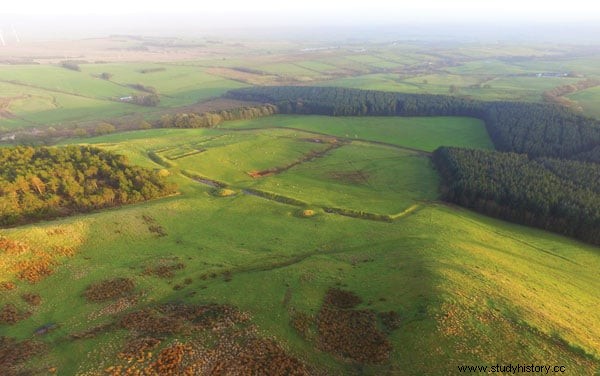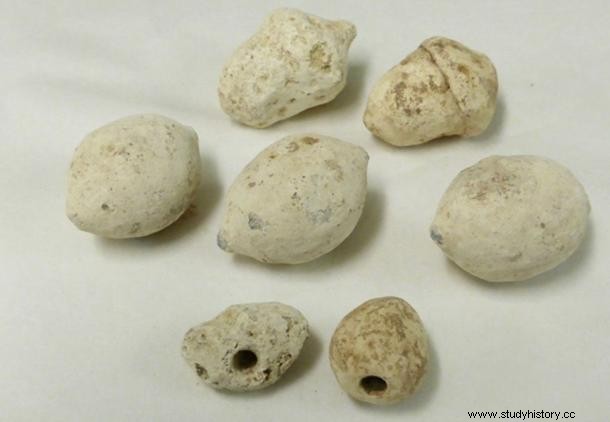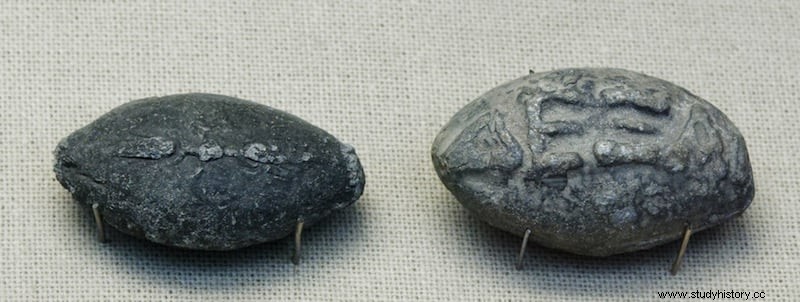Archaeologists studying Roman artillery and weapons at the Burnswark Hill battlefield site in Dumfriesshire, Scotland, they have found something that has never been seen before:perforated slingshot bullets to produce a high-pitched whistling sound when thrown. Upon examination, they believe it was a deliberate design, intended to strike fear into enemy troops.
Burnswark Hill is a fortified settlement built in the Iron Age, around which two Roman camps were found. The researchers believe that they may be siege camps set up to support the assault on the fortress, as was usual in Roman strategy. In the 1960s, some scholars argued that they could be training camps. This could explain the large number of projectiles found in the excavations during the last decades:lead bullets for slings, crossbow shots, and iron arrowheads. However the new findings reinforce the siege theory .
The bullets, molded in lead, were of two varieties, some larger in the shape of an acorn, and others a little smaller in the shape of a lemon. Now archaeologists have found a third type, a small oblong bullet pierced with a 0.5 millimeter diameter hole , and weighs only 20 grams.

At first, according to the director of the excavations John Reid, they believed that the holes served to insert poison into the bullets. Especially since making the holes would have taken a lot of time and manpower, and considering that the bullets were smaller and should do less damage, they had to have some feature that would make the job worthwhile.
However, the final theory is thatthose holes were intended to produce a high-pitched whistle when they were launched towards their targets. The tests carried out by the researchers showed that, indeed, the noise could produce a shrapnel effect when the bullets were fired in groups of three or four.

It would therefore be about intimidating the enemy and cause him to be more aware of dodging the projectiles than fighting, since he could hear the noise of these when approaching and would duck as a reflex action. In a battle the noise of hundreds or thousands of these bullets fired simultaneously could be deafening.
Up to 700 slingshots have been found at Burnswark, more than at any other Roman battlefield in Europe, scattered up to a mile around the front. The perforated ones, as we pointed out before, are unique, since they have not been found anywhere else. If it is true that on some Greek battlefields of the 2nd and 3rd centuries B.C. perforated slingshot bullets have turned up, but they were ceramic and not lead.
Lead bullets were widely used in the Greek and Roman world, since lead, being very dense, made it possible to create small bullets, with minimal air resistance, and almost invisible in flight. The most common shape was ellipsoidal, similar to an acorn, from which derives the name given to them in Latin, Glandes , which precisely means acorn .

In addition, very often symbols or messages were molded into the lead of the bullets, frequently sarcastic or humorous. If the bullet was made of clay instead of lead, it could be heated before launching it, to set fire to the enemy's thatched roofs, as Julius Caesar writes in De bello Gallico .
Burnswark Fortress would have been the victim of a Roman attack and siege during the reign of Antoninus Pius, who attempted the conquest of Scotland north of Hadrian's Wall. But after a decade the legions had to fall back behind the wall again.
